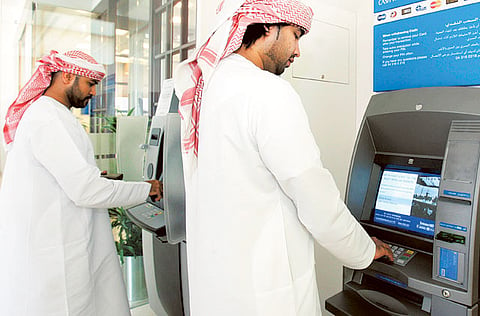UAE banks cash situation good
Healthy growth in profits and an upsurge in liquidity levels

The UAE banks are flush with depositors’ cash once again as the country’s political stability and sustainable economic growth embellish its safe haven appeal to regional and global investors at a time when the geopolitical tensions in the region are rising, particularly in Egypt, say financial experts.
They also say that much of this cash would eventually find its way into the country’s realty and stock markets which have seen a resurgence in recent months after a long lull following the global financial crisis.
“As long as there’s turbulence outside, the UAE banks are going to benefit. Interest rate offered by the banks is not the driver, it’s the stability of the UAE banking sector and the safety of the funds deposited in its banks, which is attracting the depositors,” Tariq Qaqish, head of asset management at Dubai-based Al Mal Capital told Gulf News.
Given UAE dirham’s peg to the US dollar at a time when the demand for the greenback is rising in the world, Qaqish said there are also gains to be made in the investor’s local currency should the individuals choose to keep their dollar or dirham stash as deposits in the Arab-Gulf country’s banks.
Not long ago, the UAE banks landed in a serious liquidity squeeze, after foreign banks withdrew Dh100 billion worth of funds from the local banks placed with them to make quick gains from the much-anticipated de-pegging of the UAE dirham from the US greenback, which did not happen. That move coincided with the global financial crisis that forced international banks to withdraw their surplus funds, deposits and investments from international markets, to boost their shrinking liquidity at home.
The Central Bank of the UAE and the Ministry of Finance in total made available Dh120 billion to the local banks to provide the much-needed liquidity boost. In October 2008, the finance ministry poured Dh25 billion into bank deposits to boost liquidity at banks, the first tranche of the Dh70 billion rescue facility. It deposited another Dh25 billion in November the same year.
But, that was then.
As matters stand, top UAE banks have already paid off the emergency loans taken from the federal government at the peak of the global financial crisis. The second-quarter earnings of top UAE banks last month, pointed towards a healthy growth in profits and showed an upsurge in their liquidity levels.
Latest data from the UAE Central Bank showed total bank deposits increased 0.4 per cent during the month of May to close at Dh1,246.6 billion, as a result of an increase in resident deposits by 0.5 per cent.
“Total bank loans and advances (net of provisions and interest in suspense) increased by 0.8 per cent to reach Dh1,131.1 billion, and total bank assets increased by 0.4 per cent to reach Dh1,873.5 billion, at the end of May 2013.” the apex bank said in a statement, recently.
It said during the first five months of 2013, monetary aggregate M2 increased by 6.4 per cent, while bank loans and advances increased by 2.9 per cent and total bank deposits increased by 6.7 per cent, as a result of an increase in resident deposits by 8.4 per cent.
“The money coming here would probably stay here for a long time. The UAE ranks No. 1 in terms of attractiveness in the region, given its tremendous economic growth prospects, especially due the recovery of its real estate sector,” said Haissam Arabi, an independent financial expert, based in Dubai.
The UAE’s gross domestic product (GDP) will touch $395 billion (Dh1.45 trillion) this year, before growing further to $410 billion in 2014, Sultan Bin Saeed Al Mansouri, the Minister of Economy, said in the capital in May.
Sign up for the Daily Briefing
Get the latest news and updates straight to your inbox



